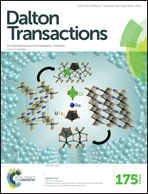A series of dinuclear lanthanide complexes with slow magnetic relaxation for Dy2 and Ho2†
Abstract
The employment of a new Schiff base ligand, 2-{[(2-hydroxy-3-methoxybenzyl)imino]methyl}naphthalen-1-ol (H2L), in 4f-metal chemistry has led to the formation of seven new isostructural lanthanide(III) complexes. More specifically the 1 : 1 reaction of Ln(NO3)3·6H2O and H2L in ethanol in the presence of 3 equivalents of pyridine yielded seven dinuclear complexes of compositions [Ln2L2(NO3)2(C2H5OH)2]·0.5py (Ln = Eu (1), Gd (2), Tb (3), Dy (4), Ho (5), Er (6), Yb (7); py = pyridine). The structures of the isomorphous complexes 1–7 were determined by single-crystal X-ray crystallography. X-ray crystallography data reveal that each compound is neutral, and contains two doubly-deprotonated ligands, two chelated nitrates and two coordinated ethanol molecules. The two LnIII atoms in 1–7 are doubly bridged by the two phenolato oxygen atoms of two L2− ligands. Each of the two lanthanide ions is eight-coordinated and possesses distorted dodecahedron geometry. Dc magnetic susceptibility studies in the 2–300 K range reveal probably a weak antiferromagnetic interaction for 2, 3 and 6, and a ferromagnetic interaction at low temperature for 4 and 5. Complexes 4 and 5 show slow magnetic relaxation behavior. The Ueff for 4 of 66.7 K is a relatively high value among the reported Dy2 SMMs. Complex 5 is a very rare example of a Ho2 compound which exhibits slow magnetic relaxation.


 Please wait while we load your content...
Please wait while we load your content...